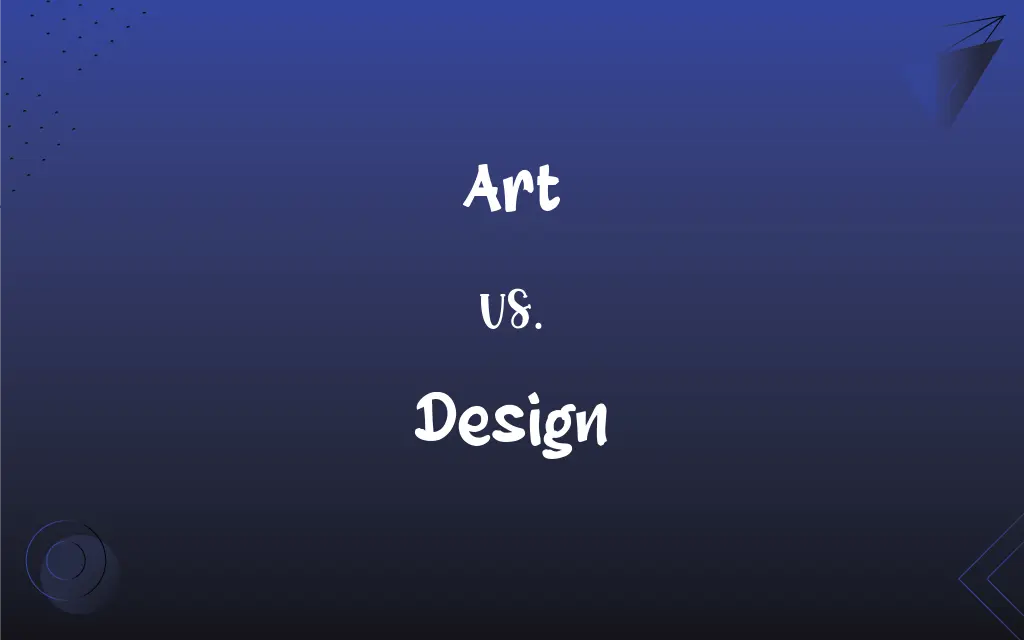Art vs. Design: What's the Difference?
Edited by Janet White || By Harlon Moss || Updated on October 25, 2023
Art expresses personal emotion and perspective; design solves a problem with functionality and aesthetics.

Key Differences
Art is a manifestation of human creativity and imagination, often driven by the desire to convey emotion, tell a story, or represent beauty. Design, on the other hand, is the process of creating solutions for specific problems, merging both form and function.
Art doesn't necessarily have to serve a practical purpose, but instead, it prioritizes individual expression and evoking feelings in the audience. In contrast, design is deeply rooted in functionality, ensuring that the end product serves a clear, user-oriented purpose.
The value of art often lies in its interpretation, where diverse audiences can derive different meanings based on their experiences and perspectives. Design is typically more direct, striving for clarity and ensuring the intended audience understands its purpose and can use it effectively.
Artists are celebrated for their unique voices and innovative techniques, with their works often open to interpretation. Designers, however, are recognized for their ability to create practical, user-friendly solutions that cater to specific needs and requirements.
Comparison Chart
Purpose
To express, evoke emotion, and interpret.
To solve problems with form and function.
ADVERTISEMENT
Criteria
Subjective and personal.
Objective, user-oriented, and functional.
Interpretation
Open to varied audience interpretations.
Aimed at clarity and direct understanding.
Result
An expressive creation.
A functional product or solution.
Constraints
Fewer constraints; driven by imagination and emotion.
Defined by requirements, user needs, and functionality.
Art and Design Definitions
Art
A human endeavor to express emotion or creativity.
The gallery showcased contemporary art from emerging artists.
ADVERTISEMENT
Design
An intention or purpose behind an action or object.
By design, the program supports new entrepreneurs.
Art
A branch of learning, often one of the humanities.
Literature is one of the liberal arts.
Design
An arrangement of elements in a particular form.
The floral design caught her eye immediately.
Art
Creative activity that produces beautiful things.
Pottery is an ancient art practiced by many cultures.
Design
The art of creating plans or drawings for something to be made.
He went to school for graphic design.
Art
Skill acquired through experience or study.
The art of negotiation is crucial in diplomacy.
Design
The aesthetic look and feel of a product or structure.
The sleek design of the phone made it popular among consumers.
Art
Works produced by artists, like paintings and sculptures.
She had a vast collection of art from her travels.
Design
A plan or blueprint for creating something.
The design for the new bridge was both innovative and functional.
Art
The conscious use of the imagination in the production of objects intended to be contemplated or appreciated as beautiful, as in the arrangement of forms, sounds, or words.
Design
To conceive or fashion in the mind; invent
Design a good excuse for not attending the conference.
FAQs
Can design be considered art?
While they have distinct purposes, design can be artistic in its approach and execution.
Does good design always have to be aesthetically pleasing?
No, but good design should be user-friendly and fit the intended purpose, aesthetics included.
Why is user experience important in design?
User experience in design ensures that the end product is usable, effective, and meets user needs.
Is design solely about how something looks?
No, design merges form with function, focusing on aesthetics as well as usability.
Is art always original?
Art is often unique, but artists can be inspired by, reinterpret, or reference other works.
Can design exist without art?
Yes, design can be purely functional without artistic elements, though they often overlap.
Is every designer an artist?
Not necessarily, but many designers have artistic skills or sensibilities.
Can one piece be both art and design?
Absolutely, many creations blend the expressive nature of art with the functionality of design.
What's more important in design: form or function?
Both are crucial, but the balance depends on the specific design project and its goals.
Are there rules in art?
While there are techniques and principles, art often thrives on breaking conventions.
Can design be spontaneous?
While design involves planning, spontaneous creativity can also play a role.
Is the value of art subjective?
Yes, art's value often lies in personal interpretation, unlike design, which has objective criteria.
Can anyone be an artist or designer?
With passion and practice, anyone can pursue art or design, though mastering them takes time and effort.
Is there a functional purpose to art?
Not necessarily; art can be purely expressive without serving a practical function, unlike design.
Does art always have to be beautiful?
No, art can evoke a range of emotions and doesn't always prioritize beauty.
Can art solve real-world problems like design does?
While art might inspire or raise awareness, design directly addresses and solves problems.
Does all art tell a story?
Not always, but art often conveys emotions, ideas, or narratives.
Can art be functional?
Yes, some art pieces can serve a function, blending the boundaries between art and design.
Do art and design require formal education?
Not necessarily; while formal education can help, many artists and designers are self-taught.
Is design always planned?
Design typically involves planning, but there's room for spontaneity and iteration.
About Author
Written by
Harlon MossHarlon is a seasoned quality moderator and accomplished content writer for Difference Wiki. An alumnus of the prestigious University of California, he earned his degree in Computer Science. Leveraging his academic background, Harlon brings a meticulous and informed perspective to his work, ensuring content accuracy and excellence.
Edited by
Janet WhiteJanet White has been an esteemed writer and blogger for Difference Wiki. Holding a Master's degree in Science and Medical Journalism from the prestigious Boston University, she has consistently demonstrated her expertise and passion for her field. When she's not immersed in her work, Janet relishes her time exercising, delving into a good book, and cherishing moments with friends and family.































































